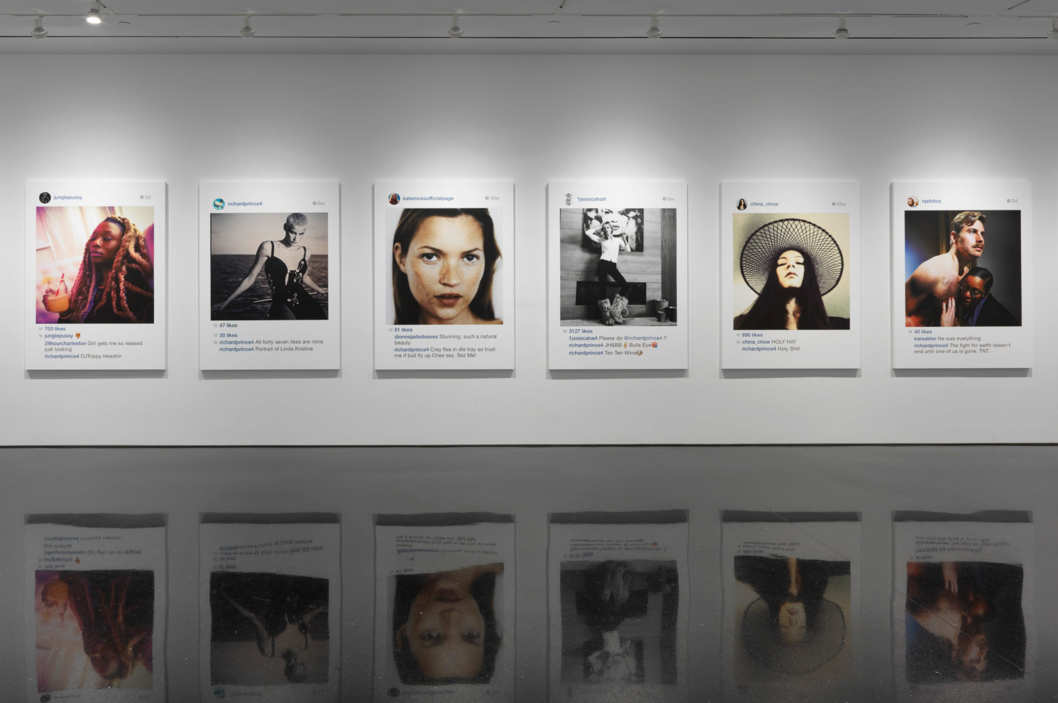Richard Prince has caused major outrage recently for putting up works of art that are screenshots of other people’s Instagram images. Though he has been doing work like this since the ’70s, I’m going to focus on the Instagram images.

Richard Prince art exhibit, Image Courtesy Gagosian Gallery. Photograph by Robert McKeever.
People are upset he is selling “other people’s” art for $90K each and not sharing the money. I keep hearing how he’s such a thief and a jerk and a liar, etc. There are several things I think people are getting mixed up and confused about.
This Is Nothing New
First, Prince is merely continuing the tradition of Marcel Duchamp. In 1917, he displayed a urinal he didn’t make and signed it with a fictitious name and called it art. People were outraged, “That’s not art!” they said. Duchamp said he had “created a new thought for that object”. “He rejected the assumption that art must be linked to the craft of the hand and instead argued that a work of art should be primarily about the artist’s idea” (SFMOA, 2015). That work of art is now one of the most influential pieces of art of the 20th century.
Prince has ingeniously applied Duchamp’s challenge to our generation’s art world. A world that is full of social media, Instagram, liking, selfies, etc. He first commented on other people’s photos on Instagram. Then he took screenshots of those photos and blew them up, and turned them into pixelated art prints. He never claims to have taken the original image, which would be lying and stealing. Instead, he claims to have taken a screenshot of the original image. He changed the context of those images and turned them into pieces of art in a gallery. People are so focused on the $90K instead of on the concept. With the pervasiveness of social media, digital art, and photography the lines of originality, copyright, and stealing are being blurred constantly. Prince is making us think hard about where those lines are.


It’s Common Behavior Among Artists
Banksy, the famous graffiti artist, also addresses the idea of continuing original artwork with his Picasso sculpture. Here he writes a quote credited to Picasso and crosses out his name and puts his own. He just took ownership of that quote by permanently engraving it onto a sculpture. Banksy creatively demonstrates the meaning of that quote. But I have not heard a single person call Banksy a fraud or thief, he just stole a quote. The idea of continuing original artwork is actually an essential part of how the art world functions.
Years ago Smashing Magazine posted an article called Tribute To Graffiti: 50 Beautiful Graffiti Artworks. This article highlights some of the best works of graffiti by referencing images taken by photographers. Most of those photographers, if not all of them, are not the original creators of the artwork. Clicking some of the images will take you to Flickr pages where the photographers have even overlayed copyrighted text on the images. Are they stealing? They did not create the original artwork in the image but yet they claim ownership of the photo. Taking a photo of graffiti is virtually the exact same thing Prince did. Again, I don’t see or hear people calling them thieves.
It’s Actually Widely Accepted Within Photography
Photographers say it’s their right to take photos of anything they want. And that they can profit off of the photos they take. Things that have trademarks and copyrights like buildings, sculptures, bridges, clothes, cars, furniture, products, paintings, etc. But when it comes to photographing photographs, it appears that’s where they draw the line. If you take a photo of a photo you are officially a thief now but everything else is fair game? That doesn’t sound fair to me.
If you are offended by Richard Prince’s art, take a deep look at your photographs. Observe how many copyrighted and trademarked things appear in your images. Of course, this doesn’t apply to all photographers, as some photographers strictly shoot nature, portraits, etc. I’m referring to photography as a whole.
Rather than being so upset about what Richard Prince is doing. Why don’t we seriously consider what he is doing and trying to say? Allow his pieces to provoke us to think critically about art. About how we are going to approach art in this modern era of digital technology. After all, none of us actually produces art that’s 100% original.
Interestingly, two of the women whose Instagram photos were used by Richard Prince admitted they didn’t even make the image they posted.